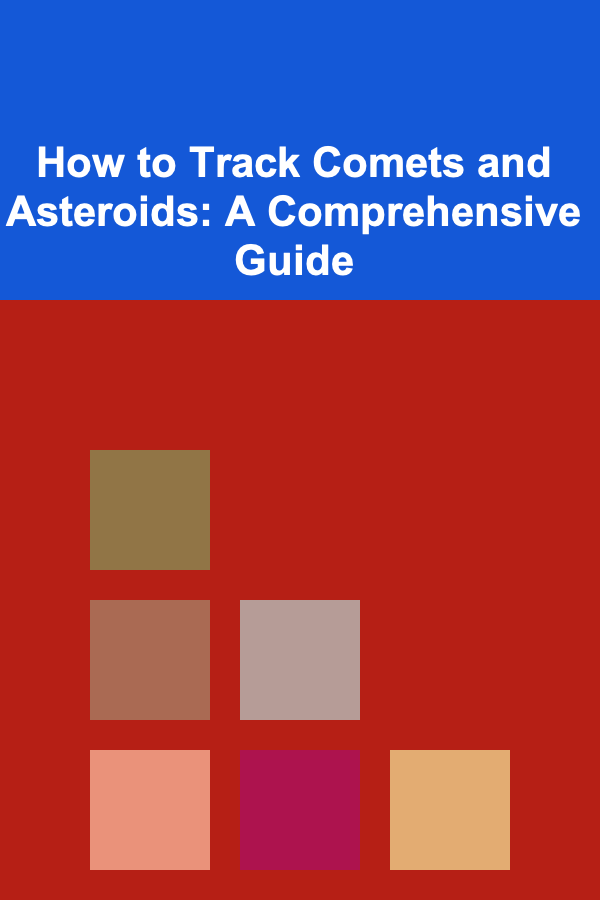
How to Track Comets and Asteroids: A Comprehensive Guide
ebook include PDF & Audio bundle (Micro Guide)
$12.99$7.99
Limited Time Offer! Order within the next:

Tracking comets and asteroids is a fascinating and rewarding endeavor that blends the excitement of discovery with the rigor of scientific observation. These celestial objects, often considered to be the "leftovers" from the early solar system, hold clues to the formation of planets and the history of our cosmic neighborhood. For amateur astronomers, tracking comets and asteroids can be a deeply fulfilling pursuit, allowing them to contribute to scientific knowledge and connect with the wonders of the universe.
In this guide, we will cover the essential methods, tools, and tips for tracking comets and asteroids. Whether you're an aspiring astronomer or someone simply fascinated by these celestial wanderers, this article will equip you with the knowledge and skills to embark on your own astronomical tracking journey.
Understanding Comets and Asteroids
Before diving into the specifics of how to track comets and asteroids, it is important to understand what these objects are and why they are significant to astronomy.
Comets
Comets are icy bodies that originate from the outer reaches of the solar system, particularly from the Kuiper Belt and the Oort Cloud. When comets approach the Sun, the heat causes them to release gases and dust, forming a glowing coma and often a tail that points away from the Sun. This tail is a defining feature of comets and is what makes them so visible and awe-inspiring.
Key Characteristics of Comets:
- Coma and Tail: The nucleus of a comet is made of ice, rock, and dust, but it is the coma (a cloud of gas and dust) and the tail that make comets visible.
- Orbit: Comets have highly elliptical orbits, which means that they travel far from the Sun and return periodically. This is why they are often referred to as "periodic comets."
- Origin: Comets are thought to be remnants of the early solar system, preserved in the cold outer regions of the solar system.
Asteroids
Asteroids, on the other hand, are rocky objects that orbit the Sun, primarily in the asteroid belt located between Mars and Jupiter. Unlike comets, asteroids do not have tails or comas because they are composed of rock and metal rather than ice.
Key Characteristics of Asteroids:
- Composition: Asteroids are made of metals and silicate rock. Some are thought to be fragments of larger planetary bodies that broke apart.
- Size: Asteroids can range in size from tiny pebbles to massive bodies that can be hundreds of kilometers in diameter.
- Orbit: Most asteroids are found in the asteroid belt, but others, known as Near-Earth Objects (NEOs), come closer to Earth's orbit.
Both comets and asteroids offer a window into the early solar system, providing scientists with valuable insights into its formation and evolution. Now that we understand the nature of these objects, let's explore the ways to track them.
Tools for Tracking Comets and Asteroids
Tracking comets and asteroids requires the right tools and techniques. Whether you're a beginner or an advanced amateur astronomer, the right equipment can make the process more effective and enjoyable.
1. Telescopes and Binoculars
To track comets and asteroids, you will need some form of optical instrument, such as a telescope or binoculars. While binoculars can be used to locate bright comets, a telescope will provide the resolution necessary to track and observe these objects in greater detail.
Telescopes:
- Refractor Telescopes: These telescopes use lenses to gather and focus light, offering clear and sharp images. They are great for observing comets and other distant objects.
- Reflector Telescopes: Using mirrors to collect light, reflector telescopes tend to offer larger apertures at a lower cost. They are excellent for faint asteroids and distant comets.
- Catadioptric Telescopes: A combination of lenses and mirrors, these telescopes offer great versatility and high-quality images. They are highly recommended for serious astronomy enthusiasts.
Binoculars:
- Binoculars are a good option for beginners. They are portable, easy to use, and can be helpful in finding comets in the night sky. For most amateur astronomers, binoculars with a magnification of 7x50 or 10x50 are ideal for tracking bright comets.
2. Astronomy Software and Apps
Technology has significantly improved the ability of amateur astronomers to track celestial objects. Several software programs and mobile apps allow users to track the positions of comets, asteroids, and other objects in the sky.
Popular Astronomy Software:
- Stellarium: This free open-source software is one of the most popular programs for amateur astronomers. It provides real-time simulation of the night sky and allows users to track asteroids, comets, and other celestial objects with high precision.
- SkySafari: A mobile app for iOS and Android, SkySafari offers detailed star charts, real-time tracking, and information on comets and asteroids. It is a handy tool for astronomy enthusiasts on the go.
- Celestia: Another open-source software, Celestia allows users to simulate the entire universe in three dimensions, making it possible to track the movement of asteroids and comets in real time.
Tracking Websites:
- NASA's Near-Earth Object Program: NASA's NEO Program provides detailed information on near-Earth asteroids, including their orbits, sizes, and potential hazards.
- Minor Planet Center (MPC): The MPC tracks asteroids, comets, and other small solar system bodies. Their website offers up-to-date information on the location and movements of these objects.
- Heavens-Above: This website provides live sky charts and tracking information for comets, satellites, and other objects visible from Earth.
3. Star Charts and Almanacs
For those who prefer to observe the sky without the aid of technology, star charts and almanacs can be valuable resources. These charts help you identify the locations of comets and asteroids by mapping the sky.
- Sky & Telescope's Almanac: A well-known resource that provides monthly updates on celestial events, including the locations of comets and asteroids.
- Astronomy Magazines and Guides: Many publications offer monthly star charts that include information on observable comets and asteroids.
How to Track Comets and Asteroids
Now that we have the tools, let's explore the steps involved in actually tracking comets and asteroids.
1. Research and Identify Objects of Interest
Tracking comets and asteroids starts with identifying which objects you want to track. While comets are often visible to the naked eye, asteroids are typically much fainter and require a telescope for observation. Some of the key sources for finding comets and asteroids include:
- Comet Catalogs : Comet catalogs such as the IAU Minor Planet Center or NASA's Jet Propulsion Laboratory provide lists of comets currently in the sky, along with details on their position and orbit.
- Asteroid Databases : The Minor Planet Center offers a comprehensive database of asteroids, including their orbits and classifications.
- Sky Guides : Websites like Sky & Telescope and Heavens-Above provide information on upcoming comet sightings and asteroid visibility for specific locations.
2. Use Astronomy Software to Locate Objects
Once you've selected a comet or asteroid to track, the next step is to use your telescope or binoculars to locate it. Astronomy software and apps, such as Stellarium or SkySafari, can be extremely helpful in guiding you to the right part of the sky.
- Enter Object Details: Input the name or coordinates of the object you are tracking into your software or app.
- Set Your Location: Ensure your location is correctly entered in the software to get accurate predictions about where the object will be in the sky.
- Track Movements: Comets and asteroids move steadily through the sky, so once you have located them, continue to monitor their positions. Many apps allow you to track the movement of these objects in real time, providing up-to-date information on their trajectory.
3. Observation Tips
When observing comets and asteroids, there are a few tips that can make the process easier and more rewarding:
- Use a Clear Night Sky: The best conditions for observing comets and asteroids are on clear, dark nights with minimal light pollution. A location away from city lights will yield the best results.
- Start with Bright Comets : For beginners, it is recommended to start with bright, easily observable comets like Comet NEOWISE or Comet Hale-Bopp. These comets are often visible without a telescope and can be a good way to practice tracking.
- Adjust for Motion: Both comets and asteroids move relative to the stars, so adjust your telescope or binoculars frequently to keep the object in view. Some telescopes come with automatic tracking features that can help with this.
4. Record and Share Your Observations
Tracking comets and asteroids isn't just about observing; it's also about documenting and sharing your findings with the wider astronomical community.
- Keep an Observation Log: Record the date, time, and location of your observations. Note any changes in the appearance of the comet or asteroid, including its brightness, shape, and position relative to stars.
- Photograph Your Findings: If you're into astrophotography, capturing images of comets and asteroids can be a challenging but rewarding task. Use long-exposure photography to capture these fast-moving objects.
- Share with the Community: If you make an interesting observation, consider submitting your data to organizations like the Minor Planet Center or local astronomical societies. Your contribution may help further scientific research.
Safety Considerations
While observing comets and asteroids can be a thrilling experience, it is essential to prioritize safety.
- Eye Protection: Never look at the Sun directly through a telescope or binoculars, as this can cause permanent eye damage.
- Safe Equipment Handling: Handle your telescope and other equipment with care, and always follow the manufacturer's guidelines for setup and use.
- Avoid Light Pollution: Be mindful of your local environment and try to minimize your exposure to light pollution by observing in dark areas or using red-light flashlights.
Contributing to Science
Amateur astronomers have played a crucial role in the discovery and tracking of comets and asteroids. Through citizen science programs, anyone can contribute valuable data to the scientific community.
- Asteroid Discovery: Some amateur astronomers have discovered new asteroids, adding to our understanding of these objects.
- Tracking Near-Earth Objects (NEOs): Observing and tracking NEOs, which are asteroids that come close to Earth, is important for understanding potential hazards and informing planetary defense strategies.
Organizations like the International Astronomical Union (IAU) and the Minor Planet Center encourage amateur astronomers to submit their observations, particularly when it comes to asteroids and other small solar system bodies.
Conclusion
Tracking comets and asteroids is a thrilling and rewarding experience that offers a unique connection to the cosmos. With the right tools, knowledge, and techniques, anyone can embark on a journey of discovery, contributing to the broader understanding of our solar system. Whether you're an amateur astronomer using binoculars or an experienced observer with a powerful telescope, the process of tracking these celestial wanderers is a deeply enriching pursuit. So, grab your telescope, download your favorite astronomy app, and begin your journey into the night sky---there's a universe of objects waiting to be discovered.
Reading More From Our Other Websites
- [Horseback Riding Tip 101] Riding with Nature: Connecting with Wildlife and Landscapes on Horseback Journeys
- [Personal Care Tips 101] How to Create Personal Care Routines for Busy People
- [Weaving Tip 101] How to Weave Functional Solar‑Panel Covers Using Conductive Yarn
- [Home Lighting 101] How to Use Recessed Lighting to Create a Sleek Look
- [Personal Care Tips 101] How to Choose a Cuticle Oil with Natural Ingredients
- [Home Staging 101] How to Appeal to All Senses: Integrating The Best Smells for Home Staging with Visual Appeal
- [Home Storage Solution 101] How to Maximize Under-Bed Storage for Small Spaces
- [Home Cleaning 101] How to Make Your Home Smell Amazing Naturally
- [Organization Tip 101] How to Use Space Savers for Bulky Items
- [Personal Financial Planning 101] How to Set Financial Goals for Short and Long Term

Building a Career in Data Science: From Beginner to Expert
Read More
How to Offer Furnished Rentals Without Breaking the Bank
Read More
How to Plan a Home Renovation Budget That Won't Break the Bank
Read More
How to Prepare for Interstellar Travel
Read More
How To Explore Quantum Computing for Drug Repurposing
Read More
How to Use GIS for Environmental Mapping and Analysis
Read MoreOther Products

Building a Career in Data Science: From Beginner to Expert
Read More
How to Offer Furnished Rentals Without Breaking the Bank
Read More
How to Plan a Home Renovation Budget That Won't Break the Bank
Read More
How to Prepare for Interstellar Travel
Read More
How To Explore Quantum Computing for Drug Repurposing
Read More